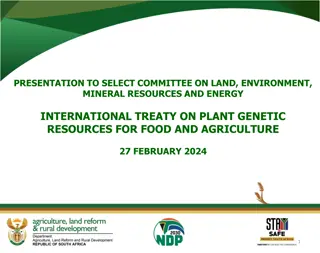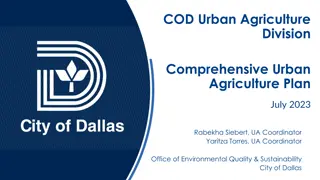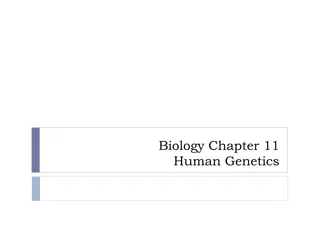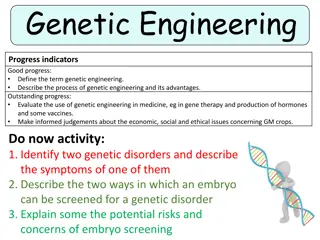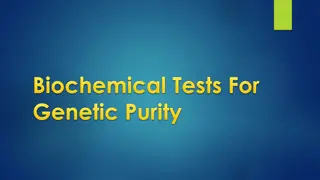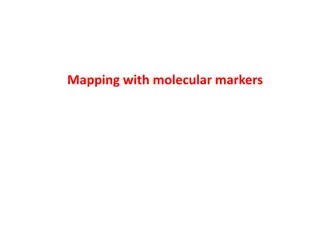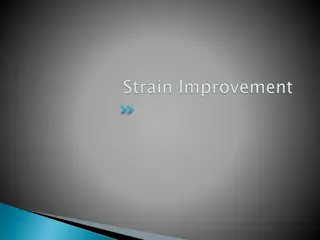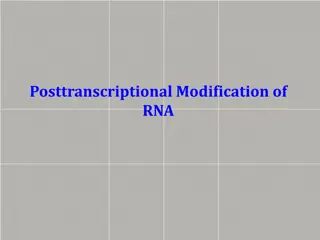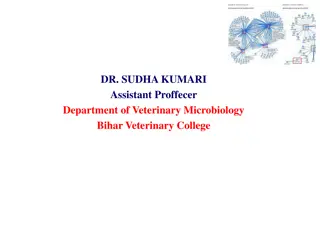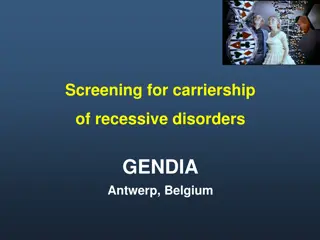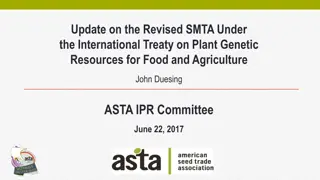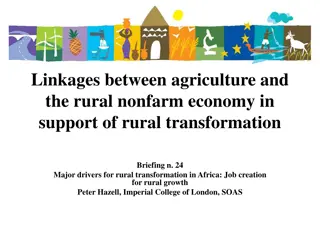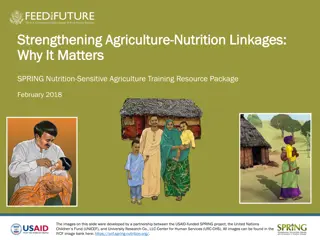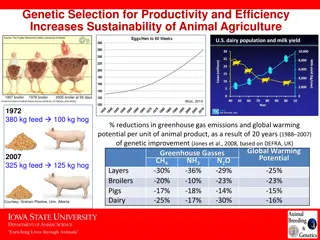Challenges and Impacts of Genetic Modifications in Agriculture
Delve into the realm of genetic manipulations in agriculture, from ancient breeding practices to modern gene therapy advancements. Explore the evolution of crops and livestock, the advent of GMOs, and the controversies surrounding gene-altered organisms. Uncover the dilemmas of resistance to chemical pesticides, biodiversity violations, and the monopolies of biotech companies in the realm of genetic modifications.
Download Presentation

Please find below an Image/Link to download the presentation.
The content on the website is provided AS IS for your information and personal use only. It may not be sold, licensed, or shared on other websites without obtaining consent from the author.If you encounter any issues during the download, it is possible that the publisher has removed the file from their server.
You are allowed to download the files provided on this website for personal or commercial use, subject to the condition that they are used lawfully. All files are the property of their respective owners.
The content on the website is provided AS IS for your information and personal use only. It may not be sold, licensed, or shared on other websites without obtaining consent from the author.
E N D
Presentation Transcript
1 Genetic manipulations, Gene therapy CRISPR revolution OLIVER R CZ, 2016
Gene manipulations the beginnings? 2 Agriculture more than 12 000 years ago Mesopotamia, Europe Breeding, crossing of plants, animals The current maize, corn, rice is very different from the original natural types. High yield, some negative characteristics The same in domestic animals (dogs, cats, horses, pigs, cows, poultry) SLOW GENETIC MANIPULATION
Direct gene manipulation from 1970 3 Recombinant DNA technology restriction enzymes from bacteria Cutting out genes from different species Insertion of genes into the genome of viruses, bacteria, yeast Infection of the target with the virus gene transfer small probability of success and temporary effect OR: Production of proteins from inserted genes in vitro
20th Century 4 Drug production in yeast and bacteria Human insulin, growth hormone, erythropoetin Some products from milk or urine of domestic animals Gene therapy only somatic , not very successful (cystic fibrosis, immunodeficiencies) Gene Modified Organisms (GMO) = agricultural products and food Anxiety and fear of lay (not educated) people Business and politics
Most widespread in USA 5 Soya 89 % Maize 61 % Corn increasing And also in Argentina, Brazilia, Canada, China, India together 114 mil. ha. Estimated increase to 2025 cca tenfold but in 2016 a small decrease The solution of starvation in developing countries? Where is Africa?
The problems 1 6 In the first years no improved products but resistance against chemical pesticides! Sowing of seeds, strong spraying the fields against weed and pests. The soya is growing but! The second step seeds resistant against pests but only one generation (suicidial genes) The possibilities of horizontal transfer? Arise of resistent weeds (they are here anyway)
The problems 2 7 Monopoly of some companies Only for big producers, not for small farms Monocultures biodiversity violation (already present but GMOs increase the danger) Pest spread in association with monocultures BUT NO DANGER OF CONSUMPTION OF FOODS FROM MODIFIED FRUITS OR VEGETABLES
8 The public is against USA 55 %, CAN D 81 %, F EU embargo 1998 protection of EU market??? SK two thirds of population have no idea about it 61 % 89 % MAIZE MON810 IS PERMITTED RESISTAND AGAINS AN IMPORTANT PEST. ONLY FOR ANIMAL FEED SK 1 900 hectares from 120 000, BETTER YIELDS, BUT A LOT OF PAPERWORK New trends Biofoods, fair trade, etc, etc Slogan or truth? Only for rich people?
Gene therapy 9 Gene therapy = treatment or prevention of diseases through gene transfer into somatic cells not only for hereditary diseases! First years big expectations 3 scientific journals, 30 companies, 300 protocols and more than 3000 probands In vivo and ex vivo methods Broad scale of vectors and their delivery to the target cells but they were far from perfect Later disillusionment A new start not long ago better results in some rare diseases, no breakthrough in everyday medicine
Gene therapy 10 Clinical protocols Malignant tumoursy Monogenic diseases Infectious diseases Cardiovascular Vectors: mostly retro- or adenoviruses Switching on and off the genes (expression regulation) is a problem Problems 700 side effects, some fatalities. Lack of informed consent. Falsified results! 216 (suicidial genes) 49 (SCID ADA def.) 24 8
CRISPR-Cas9 revolution 11 What is it? Clustered regularly interspaced short palindromic repeats A defense mechanism of bacteria against viruses (recognition of viral genes through complementarity) Cas9 = enzyme cutting both chains of DNA How can we use it in human biology and medicine? Exactly directed cuts of DNA, simple manipulation The possibility of gene editing (mutation repair) SOMATIC: OK GAMETIC ??? OLD METHODS SCISSORS; CRISPR: INTELLIGENT SCISSORS!
All hands on the desk 12 ADDGENE FROM 2013 60 000 ORDERS OF ASSAY KITS GENE EDITING AS A CURE OF THALASSEMIA (EXPERIMENTAL) OTHER POSSIBILITIES: BROKEN SCISSORS CAS9 DOES NOT CUT BUT BLOCKS THE GENE EXPRESSION. STUDY OF ALZHEIMER AND OTHER DISEASES CRISPR AND GENE ACTIVATION CRISPR AND BLOCK OR ACTIVATION OF EPIGENETIC FACTORS CRISPR AND OPTOGENETICS GENE SWITCH WITH LIGHT IMPULSES STUDY OF NONCODING REGIONS NEGOTIATIONS ON ETHICAL ISSUES (GAMETIC GENE REPAIR)
CRISPR ZOO 13 EGG ALERGY BLOCK OF EGG PROTEIN EXPRESSION IN CHICKEN DIFFERENT IMPROVEMENTS OF DOMESTIC ANIMALS (MORE MEAT)??? BULLS WITHOUT HORNS??? DIEASE RESISTANT BEES MALARIA OR ZIKA RESISTANT MOSQITOES DE-EXTINCTION OF MAMMOOTHS? MUSHROOMS WITH SLOW DECAY ALREADY APPROVED ANIMAL MODELS OF HUMAN DISEASES


